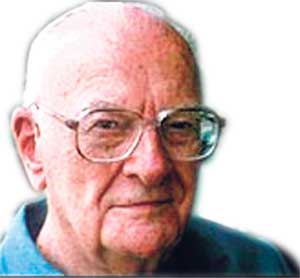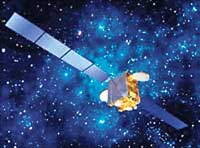
Sir Arthur C. Clarke: Sci-fi seer
Sir Arthur's vivid – and detailed – descriptions of space shuttles, super-computers and rapid communications systems were enjoyed by millions of readers around the world. His writings gave science fiction – a genre often accused of veering towards the fantastical – a refreshingly human and practical face. His ideas and gadgets engaged his readers because of, not despite, their plausibility. Quite often, his fictional musings formed the basis of what we now see as science fact. A youthful interest in dinosaurs and Morse code blossomed into a fascination with all things scientific. During World War II, Sir Arthur volunteered for the Royal Air Force, where he worked in the, then highly-secretive, development of radar. Demobbed at the war's end, he went to King's College, London, where he took a First in Maths and Physics, before becoming a full-time writer in the late 1940s. He wrote story-lines for the comic-book hero, Dan Dare, inspired Gene Roddenberry to create Star Trek and posited Clarke's Law: "Any sufficiently advanced technology is indistinguishable from magic." Beyond this, during the war, he published a paper in which he predicted that, at 22,000 miles above the Earth's surface, communications satellites would sit in geo-stationary orbit, allowing electronic signals to be bounced off them around the globe.
No wonder, then, that Sir Arthur counted both Rupert Murdoch and CNN founder Ted Turner among his friends and acolytes. But it was his creation, with the legendary film director Stanley Kubrick, of 2001: A Space Odyssey, that brought Sir Arthur world-wide fame. Based in part on his short story, Sentinel, the film quickly established itself as a cult classic. Its mysterious monoliths, the psychopathic Hal 9000 computer and a final sequence which baffled many cinema-goers have become frequently-referenced icons of cinema. He lectured, was feted by everyone from the astronaut Buzz Aldrin to R. Buckminster Fuller, inventor of the geodesic dome, and appeared on television, most notably in Arthur C. Clarke's Mysterious World. He moved to Sri Lanka – then called – Ceylon, in 1956. There he lived with a business partner and his family, scuba-dived and played table-tennis with local youths. A seer of the modern age, Sir Arthur was an original thinker, a scientific expert whose tales combined technology and good old-fashioned storytelling and whose influence went far beyond the written page. Marking his 90th birthday last year, he told fans: "I want to be remembered most as a writer. I want to entertain readers and hopefully stretch their imaginations as well. If I have given you delight by aught that I have done, let me lie quiet in that night, which shall be yours anon." |
|
||||||
|| Front
Page | News
| Editorial
| Columns
| Sports
| Plus
| Financial
Times | International
| Mirror
| TV
Times | Funday
Times || |
| |
Reproduction of articles permitted when used without any alterations to contents and a link to the source page.
|
© Copyright
2008 | Wijeya
Newspapers Ltd.Colombo. Sri Lanka. All Rights Reserved. |
 Once called "the first dweller in the electronic cottage," his vision of the future, and its technology – popularised in films like 2001: A Space Odyssey – captured the popular imagination.
Once called "the first dweller in the electronic cottage," his vision of the future, and its technology – popularised in films like 2001: A Space Odyssey – captured the popular imagination.  2001
2001